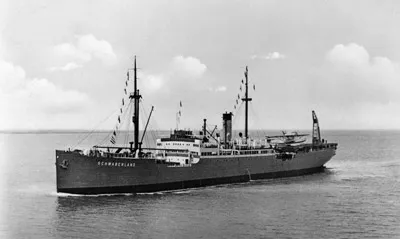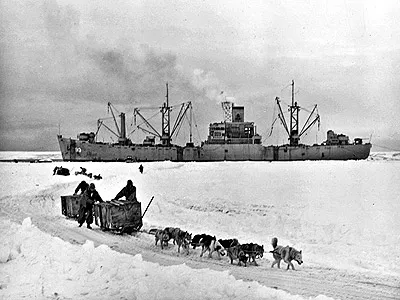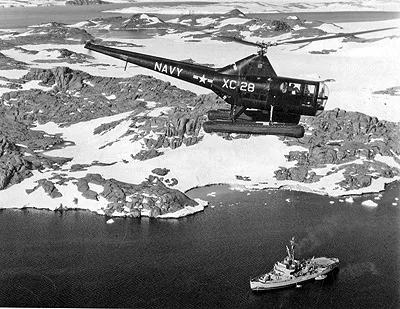
Hitler's Frozen Base
The fact that an opinion has been widely held is no evidence
whatever that it is not utterly absurd.
- Bertrand Russell,
1872-1970
A wise man ... proportions his belief to the evidence - David Hume, 1711-1776
In the late 1930's, the Nazi's showed an interest in Antarctica and sent a expedition to survey a part of it and claim it for Germany, the claim was not continued but it sowed the seeds for a whole range of fantasies about secret things that might be going on.
What really happened?
Neuschwabenland
A little known German expedition to Antarctica from the 17th of December 1938 to the 12th of April 1939 on the ship MS Schwabenland had the purpose of claiming an area now known as Dronning Maud Land mainly to protect the German whaling industry. This area however had been previously explored by Norway and was formally claimed by the Norwegians in January 1939 after the Germans had set sail but before they arrived in Antarctica.
The Schwabenland was equipped with a steam catapult and two Dornier Wal flying boats which were used to photographically survey 600,000 square kilometres. About a dozen aluminium flags were dropped from the aircraft at turning points of flight polygons and others were left by foot expeditions, none of these have ever been recovered. The land surveyed was claimed by Germany in August 1939 as "Neuschwabenland" named from the ship. The outbreak of war prevented two further planned expeditions and the possible building of a base, though most probably to the other side of Antarctica in the Pacific sector away from the Norwegian claim, the claim was abandoned in 1945.
There is no evidence of any further German activity in Antarctica during World War 2.
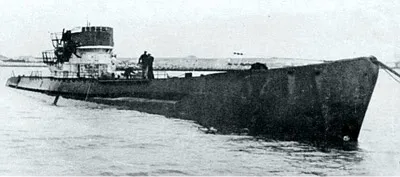 U-530 at Mar del Plata in July 1945 being inspected by an Argentinian boarding party. |
On the morning of the 10th of July 1945, the German U-boat U-530 arrived at the Argentine naval base at Mar del Plata near Buenos Aires, two months after the German surrender and the end of the war in Europe on the 8th of May 1945.
Rumours spread that it had brought Hitler, Eva Braun, Martin Bormann and others and had landed them on the coast of Patagonia or Antarctica before reaching Mar del Plata. A week later a Hungarian exile in Argentina, Ladislas Szabo wrote a detailed account in a local newspaper of how Hitler and his entourage had supposedly escaped Germany. The story quickly spread worldwide and versions of it appeared in other newspapers in many countries. On the 17th of August, another U boat, U-977 also arrived at Mar del Plata, further fuelling speculation.
The commanders of these U-boats and their crews were arrested and interrogated by naval personnel from Argentina, the USA and the UK, they all concluded that the arrivals were innocuous and the crews were released.
Two years later in 1947, Szabo published a book "Hitler is Alive" where he claimed these two U-boats had taken fleeing senior Nazis to Antarctica as part of a submarine convoy, the commander of U-977 in particular, Heinz Schaeffer denied this but the rumour still spread. In another version of the story, it is Hitler's ashes that were taken to Antarctica and placed in a special ice-cave along with Nazi treasure.
Szabo claimed a Nazi Antarctic base called "New Berchetesgaden" had been built in 1938-39, this idea has been taken up by several authors over the years often building on earlier embellishments with tales becoming ever more fantastical as time went on.
The submarine convoy and the "New Berchetesgaden" base both first appear when described by Szabo, there is no reference to either before his publications, subsequent publications refer to what he initially described and there has never been any evidence of either.
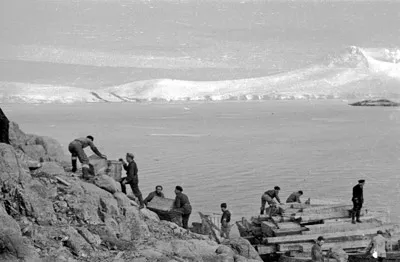
Unloading supplies to build and equip a base at Port Lockroy, Antarctic Peninsula, British claimed sector, Operation Tabarin 1944. |
Secret British Wartime operations
While the Germans were not active in Antarctica during the war, the British were. Great Britain had claimed the sector of Antarctica between 20°W and 80°W and to the South Pole in 1908, Argentina claimed pretty much the same section from the mid 1920's and so did Chile in 1940, Argentina and Chile were both friendly with Germany.
From February 1944 Great Britain occupied the region of their claim to rebut the competing claims from Argentina and Chile under the guise of obtaining information about German shipping raiders and U-boats in the region. A number of permanently manned bases were established to this end each with a handful of personnel under Operation Tabarin. Much scientific data was collected during this time and after the war, work continued as the Falkland Islands Dependencies Survey which later became the British Antarctic Survey.
Operations Highjump and Windmill
Operation Highjump 1946-47 and Operation Windmill 1947-48 (the Antarctic summer seasons) were United States Navy operations with Highjump being the largest ever group to go to Antarctica consisting of 4,700 men, 13 ships and 33 aircraft. The main purpose was to prepare for and practice techniques for cold weather warfare in polar conditions while being diplomatically far away from the Arctic and Russia. It was primarily a military exercise with a number of other important objectives such as establishing a research station, investigating further potential base sites, extending the sovereignty of the Unites States to an extensive region of the continent, and surveying the electromagnetic, geological, hydrographical and other scientifically important aspects of the physical environment.
Operation Windmill was a follow-up much smaller exercise the following year, an important part of which was to obtain ground references for the 70,000 aerial photographs taken during Highjump the previous year. Helicopters were used extensively, hence the name Windmill being given to the operation.
Nuclear Explosions
In August and September 1958, three nuclear explosions were detonated by the United States as part of Operation Argus over the South Atlantic between 38.5° and 49.5° south between 2,280 and 3,500km north of Antarctica to the southwest of South Africa. These were high altitude bursts and as might be expected at the time at the height of the Cold War were shrouded in secrecy, though they were reported soon afterwards in 1961.
Contortions of the Truth and Invented Narratives
As we have seen above, the evidence-free stories about a Nazi Base in Antarctica began within a week of a submarine turning up somewhere unexpected shortly after the Nazi surrender in 1945. The items I outline above are factual, though they have been used repeatedly as a scaffold to support all manner of fantasies that may or may not fit together.
There are a number of narratives from several authors which follow similar patterns with some variations. The basic story is that a German base in Antarctica was established just before the war by the Schwabenland, this was expanded during the war being regularly supplied by submarine deliveries, it was used to develop sophisticated secret weapons. This base was spied on by the British who attempted unsuccessfully to destroy it in an SAS raid in 1945. Operation Highjump was sent to attack the base, though they were repulsed by secret weapons (flying saucers are often mentioned), then eventually the base was destroyed by nuclear bombs in 1958. By the time of its eventual destruction the base is often described as being populated by hundreds or even thousands of people and defended by a range of sophisticated weaponry including the flying saucers. Of course all of the stories claim that there has been suppression of facts and evidence by the British, Americans and anyone else you care to name, the lack of evidence is therefore presented implicitly as evidence.
While a lack of evidence makes something much less likely, the absence of evidence is not the same as the evidence of absence. What follows is a short account of why the claims of a secret Nazi base are not only baseless (did you see what I did there?) but ridiculous. For a more in depth explanation and discussion, see: Summerhayes and Beeching, (2007) Polar Record 43 (224): 1-21. Hitler's Antarctic Base: The Myth and the Reality download here
The Secret Nazi Antarctic Base
Different authors claim different building times and locations of the supposed Nazi base, sometimes it is described as being in a warm ice-free oasis with lakes, sometimes pictures of other areas are misrepresented or just plain faked.
- While there are ice-free or relatively ice-free
areas in Antarctica, they are not warm, the lack
of ice is due to the prevailing winds and low snow deposition,
not melting.
- The supposed warm ice-free caves under the ice/ground
and source of geothermal energy to supply the base do not
exist in Dronning-Maud Land, while there is geothermal
and even volcanic activity in other parts of Antarctica,
this area is particularly geothermally quiet.
- Time and logistics. The base described
as first built in 1939 is usually described as being about
250km inland across a previously unexplored and unmapped,
crevassed and sloping ice shelf. The ship Schwabenland was
in the area for about a month. Previous Antarctic bases
that had been established by Scott, Shackleton, Amundsen
and others took at least two weeks to construct the base
buildings. The Germans were inexperienced in such things
and transport across 250km of uncharted ice field would
have been difficult and time consuming even for the experienced.
The Dornier aircraft had a payload equivalent of about 10
people and being flying boats were unable to land and take
off safely on a glacier or ice cap so could not have been
used for transport. There was simply not enough time or
the resources to build a base so far inland in such a short
space of time even to house just a dozen or so men as had
happened previously let alone the hundreds imagined by authors
who described the base.
- There have now been well over 1,000 scientists who have visited the area of Newschwabenland, several scientific bases have been established there since the 1950's, the whole area has been mapped by satellite and considerable air traffic has criss-crossed the area, none of this has led to the reporting of even the slightest evidence of a wartime Nazi base. As it was supposedly built in an ice-free oasis, it would not have been buried by snow.
British Operation Tabarin
There is a claim that the British set up a base called Maudheim-1 (there are no records) in Dronning Maud Land during the war to observe the apparent Nazi base, this was supposedly attacked by the Nazis in July 1945 followed by SAS led (failed) retaliatory attacks from October to December that year.
- While Operation Tabarin was a military led wartime
mission and secret at the time, all records are in the public
domain and no base was ever built in Dronning Maud
Land, which as it is in the Norwegian claimed sector is
as expected. The main purpose of Operation Tabarin was to
establish a British scientific presence in the British claimed
sector where all of the wartime bases were built. These
bases were all tiny with a compliment of between 4 and 9
men.
- There was no SAS presence in Antarctica during
the war. There were three de-mobbed ex-SAS men
in the Falkland Islands in 1945-46 after the war who became
involved in the Falkland Islands Dependencies Survey, the
civilian development of Operation Tabarin seeing the possibility
for a civilian adventure in Antarctica. The SAS had been
disbanded in October 1945 and would not be reformed until
1948.
- A number of bases were established in and around the Antarctic Peninsula area from February 1944, each was very small and they were frequently visited by shipping during the summer months with personnel being changed over or moved to other locations. They would also often be closed down and another opened as more or less advantageous places to build a base were discovered by trial and error. This perfectly normal and explicable behaviour has been suggested as being somehow significant or mysterious, it isn't.
U-530 and U-977
Did these U-boats visit Antarctica before turning up in Argentina two months after the end of the war in Europe?
- Interrogation reports of the crews of these
two submarines showed that U-530 was off New York when the
news reached them of the German capitulation on the 8th
of May 1945, while U-977 was off the coast of Norway.
U-977 put 16 men ashore who chose to go near Bergen, and
then the rest of the crew (now reduced from the normal number)
made their way to German-friendly Argentina. Both boats
had to travel quite slowly to conserve fuel, they travelled
on the surface at night and below the surface during the
day to avoid capture, this slowed them down further. The
time taken for them to reach Argentina is exactly within
the travelling time and speeds they could make during their
separate journeys. Embellished claims were made that the
U-530 that turned up in Argentina was in fact a much faster
and larger boat than the "real" U-530, as usual
without any evidence, even to the point where the supposed
performance was significantly beyond any U boat in service.
- June and July when the submarines were claimed
to be in Antarctica are the depths of winter there.
Winter storms, 24 hour darkness and a formidable skirt of
seasonal sea-ice 1-2m thick before the continent is even
reached prevent any shipping operating in the winter even
today, let alone small 1940's submarines without any
ice strengthening. Satellite data shows that this sea-ice
in the Dronning-Maud Land region extends from the coast
by about 500km in May and June and 1,665km in July. Then
there is the presence of huge ice-bergs, the difficulties
of under-ice navigation and a 250km crevasse strewn inland
journey largely in the dark with winter temperatures of
down to -50°C once the submarines had landed.
- There is no evidence whatsoever of a convoy of submarines that these two boats were supposedly part of, going to Antarctica or elsewhere.
Operation Highjump
It is claimed by several authors with no supporting evidence that the purpose of Operation Highjump (1946-47) was to destroy the supposed Nazi base in Dronning-Maud Land.
- Highjump was primarily a military rather scientific
expedition, one of a number at the time designed to prepare
for potential cold weather warfare in the Arctic, while
being diplomatically far enough away from the Arctic and
Russia. It was widely written about in the press
at the time and accompanied by 11 journalists rather than
being secret as was the British Operation Tabarin. Books
published shortly afterwards were written by people on the
expedition and an official report released later in 1947.
Though classified as confidential and not made available
to the general public, it was never classified as secret,
there was nothing in the official report that was substantially
different to the report about Operation Highjump in a National
Geographic magazine issue in 1947.
- Operation Highjump was centered on Little America
IV, a new base that was built as part of the activities.
This was on the Ross Ice Shelf on the opposite part of the
continent to Dronning-Maud Land which was at the
extreme limit of the planned exploration area.
- The ships didn't leave the USA until late in the season, December the 2nd 1946, and arrived late to the Ross Sea after meeting a 1000km wide belt of pack ice. They unloaded supplies and materials for the Little America IV base on the 15th of January 1947 and left again as winter began to arrive on the 23rd of February 1947 to avoid damage to the ships that didn't have ice strengthening. They did not leave as claimed in some more fantastical descriptions because they were chased off by "secret weapons" or "flying saucers" from the Nazi base on the other side of the continent. A short summer season is usual in the Ross Sea region due to variable sea-ice and the relatively unpredictable advent of the Austral winter, the whole operation got off to a late start and the weather-forced early end was not unanticipated. Activities of all kinds in Antarctica are primarily dependent on the weather and sea-ice conditions rather than strict dates on the calendar. It was intended to last longer than it did, but still only weeks rather than many months as sometimes claimed.
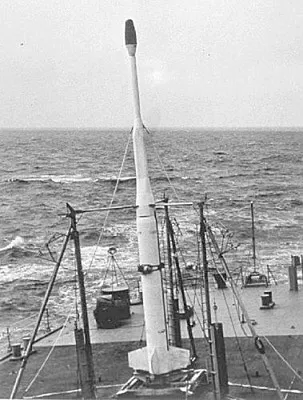
X-17 missile with a nuclear warhead during Operation Argus on board USS Norton Sound, AVM-1. |
- The invented narrative says that in 1958, 3
nuclear bombs were used to destroy the Nazi base in Dronning-Maud
Land. The reality is that they were high altitude
test explosions for a particular purpose of potentially
interfering with radar, radio and electronics of satellites
and missiles. They were exploded between 2,280 and 3,500km
north of Antarctica. Antarctica is a much studied environment
in part because it is clean with virtually no pollution.
Ice cores taken show peaks of radioactive fallout from 1950's
and 60's nuclear tests thousands of km away in chronological
order as they are trapped within seasonal snowfall and accumulation
and so recorded. Nuclear explosions directly over Dronning-Maud
Land in 1958 would show dramatic peaks of radio isotopes
if they happened, no such evidence has ever been found in
any ice cores taken.
- 1958 was part of the International Geophysical Year when there was great international co-operation to study the polar regions including the establishment of many temporary and permanent scientific bases. At this time there were Belgian, British, Japanese and Norwegian scientists living on newly established bases in the area, nuclear explosions would have been noticed and reported.
Conclusions
Has this analysis been a sledge hammer to crack a nut? Any sensible minded person wouldn't give the Nazi Antarctic base fantasy the time of day. The time it has taken me to write this page or for Messers. Summerhayes and Beeching to research and write their excellent paper debunking the ideas formally is arguably beyond what the effort is worth. After all, anyone who might consider such things as true is probably not going to bother reading a detailed analysis about why they can't possibly be so.
It is however satisfying to be able to address each particular claimed fantasy element as demonstrably false.
Quite often when presented with conspiracy theories with ridiculous and baseless claims we suspect that such a task could be undertaken, though the time taken can be onerous and so it generally doesn't happen. Here is one that shows what can be done with what has been a widespread and enduring fantasy over the years.
"One fool can ask more questions than seven wise men can answer."
Connected pages: More Hidden Antarctic Secrets | Military activity, and other nonsense
Summerhayes and Beeching, (2007) Polar Record 43 (224): 1-21. Hitler's Antarctic Base: The Myth and the Reality - For a more in depth discussion of the matters on this page see this academic peer-reviewed paper with full references of the facts and events discussed. download

